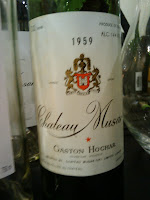

The cool climate region of the Yarra Valley is located around an hours drive from Melbourne south eastern Australia. Cool climate in that there is considerable variation in altitude and aspect that even the warmest sites of the Yarra Valley are comparatively cooler than the other Australian viticultural regions. In comparison to French growing regions the Yarra Valleys climate is slightly warmer than Burgundy, yet cooler than Bordeaux.
Yering Station Shiraz Viognier 2006
95% Shiraz, 5 % Viognier
Served after a 4 hour decant this deep garnet wine clinged to the glass with firm legs and immediately started to give off its pronounced aroma of dark and red fruit with blackcurrant, dark cheery, a little blueberry and a baked blackberry black current crumble fresh from the oven with spice, pepper and a smoky vanilla topping. Quite dry on the palate with some acidity the smooth body shows a very clean tannin structure, creamy but not in a full bodied round oaked thick kind of way. I feel some very northern Rhone tobacco notes to this well balanced wine. This wine was a great buy at around £10 and certainly gave a good imitation of some of the far more pricey Cote Rotie wines. 91/100
Find this wine on Wine-Searcher























































